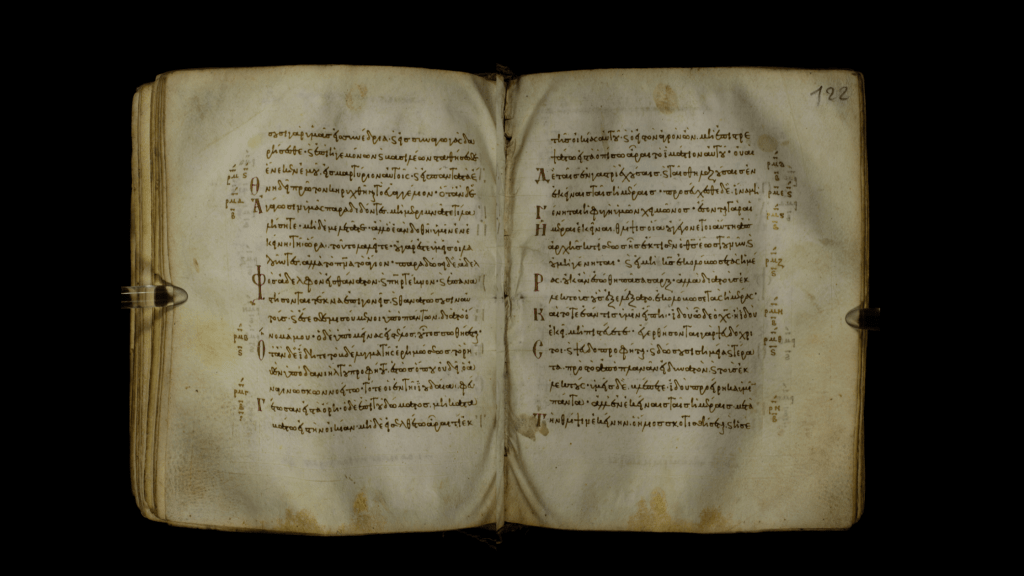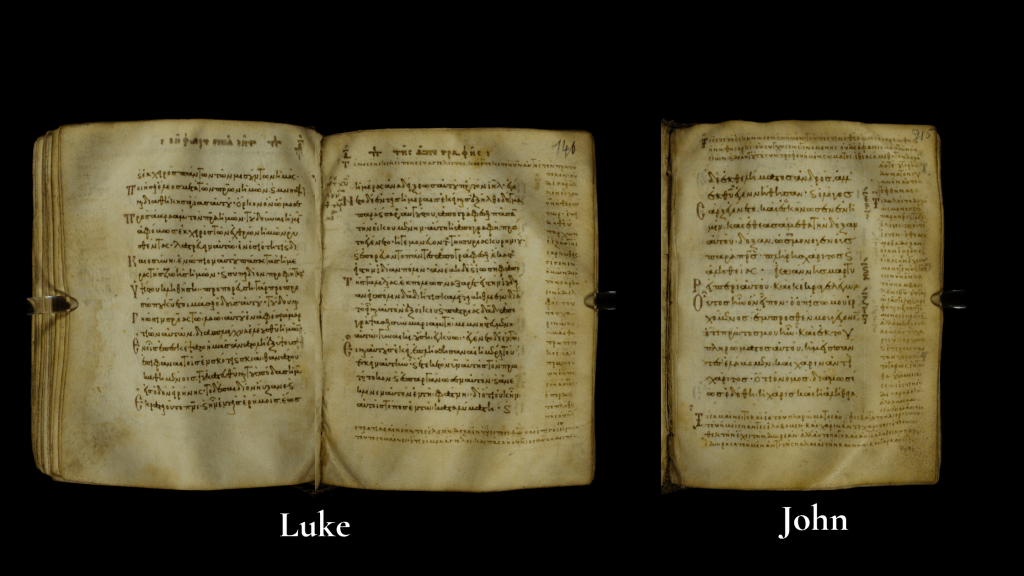By: Andrew J. Patton, Guest Contributor
Andrew J. Patton is a doctoral candidate on the CATENA Project at ITSEE in the University of Birmingham, studying Greek catena manuscripts on the Gospels. Prior to studying at Birmingham, he worked for CSNTM as the Development Manager and on digitization expeditions.
This From the Library blog features an eleventh-century Gospels and commentary manuscript. This manuscript named Gregory-Aland (GA) 2097 has a unique story to tell. It belongs to the Library of the Hellenic Parliament in Athens, Greece, where I had the privilege of digitizing it with Andrew Bobo as part of CSNTM’s expedition in 2017. While we know little about GA 2097’s background, a closer inspection of the text and the artifact itself sheds light on the ways its owners read the Gospels.
Making the Manuscript
Viewing the manuscript at the library and in CSNTM’s digital manuscript collection leaves an indelible impression that this was a fine production. The preparers of the parchment neatly trimmed the pages and carefully washed the animal skin to a lighter shade so that the distinctions between the ‘hair’ and ‘flesh’ sides are less apparent.

The script stands out because both the biblical text and commentary were copied in very neat handwriting. Scribes tended to copy the New Testament text quite legibly, but commentaries—even in biblical manuscripts—were often written with cramped or less precise handwriting. However, in this manuscript we find both the scriptures and the commentary in as carefully written, readable handwriting. The scribe wrote the text of the Gospels in a cursive minuscule form. Many of the letters were also decorated with gold and red ink. The commentary script framing the minuscule NT script is in a careful, semi-majuscule hand with widely spaced letters.

The different writing styles create a strong visual distinction between the commentary and the scripture. It is possible that different scribes wrote the two visually distinct texts.
The combination of a neatly written, decorated manuscript on fine parchment suggests that GA 2097 may have been commissioned as a deluxe manuscript.
The Text of the Manuscript
The biblical and commentary texts also show some of the ways Christians read and interpreted the Gospels. Notably, the manuscript does not include the story of the woman caught in adultery (John 7:52–8:12)—one of the longest and most famous textual variants in the New Testament. On the other hand, it does include the long ending of Mark (Mark 16:9–20). Including one of these famous textual variants and not the other is not uncommon, though the majority of manuscripts do include both.
The commentary perhaps gives a more unique perspective on Gospel reading and tradition. We call the type of commentary in GA 2097 catena, which is the Latin word for “chain.” A catena commentary consists of a series of extracts taken from the homilies and letters of various early Christian writers arranged together into a running commentary on the biblical text.
At first glance, one might assume that the scribe of the catena commentary in GA 2097 may have grown lazy or became overwhelmed by the scope of the task because of how many pages have no commentary. While there is extensive commentary in Matthew, Mark has none and Luke contains frequent gaps. The book of John, however, appears to have a more complete commentary.


An unfinished commentary, though, would not align with all the other signs showing that this was a carefully made, high-quality production. Instead, these gaps more likely followed the catena tradition and present a reproduction of an edited form of an earlier manuscript.
The commentary in catena manuscripts generally was not the original composition of the scribe—i.e., picking and choosing comments from the original sources or remembering their favorite quotes. Rather, scribes tended to create new copies of existing catenae with some modifications or mistakes. In this manuscript, the catenae covering the three Gospels—Matthew, Luke, and John—have been identified as the oldest known catenae versions for these gospels. All three were produced by the same unknown figure in the sixth or seventh century. Matthew and John were, at the time, the most widely read and interpreted Gospels by ancient Christians, so they have longer commentaries. The catena in Luke is shorter because the unknown catenist usually skipped parallel passages in Matthew since those had already been treated. This could explain why Mark, sharing almost all its text with Matthew or Luke, went entirely without commentary. The amount of commentary for each book, then, reveals a glimpse of Gospel catenae history. While older editions of catenae comment on all of Luke and Mark, the early form in GA 2097 shows that there once was a higher frequency of interpreting Matthew and John.
The Later Life of the Manuscript
While GA 2097 stands today as a beautiful example of a medieval Gospels and catena manuscript, at one point it was even more impressive. Sadly, thieves cut out the most beautiful leaves in the manuscript. The most elaborately decorated pages in a Greek New Testament manuscript are usually the Eusebian Canon Tables at the beginning of the manuscript and at the beginning of each Gospel.

At some point, these leaves were removed by a thief—probably to pad their personal collection or to sell for profit. Unfortunately, this occurred frequently with biblical manuscripts because of a lucrative market for single illuminated manuscript leaves, especially in the United States after the 1900s. These tragic thefts reflect the ways that biblical manuscripts often tell not only the sacred stories of liturgy and spirituality, but also the stories of greed and imperialism.
Gregory-Aland 2097
While medieval Gospels and commentary manuscripts like GA 2097 rarely receive detailed and frequent examination like many of the more famous and older copies of the Greek Bible, they still bear interesting characteristics and rich opportunities for future studies. The images captured by CSNTM allow thorough research on this manuscript to take place from anywhere in the world and from a variety of perspectives. I am one of those beneficiaries, as I have consulted the images for my doctoral thesis research on Gospel catenae at the University of Birmingham. We are grateful to the Library of the Hellenic Parliament for partnering with CSNTM to digitize this manuscript and for allowing images of it to be shared online.


